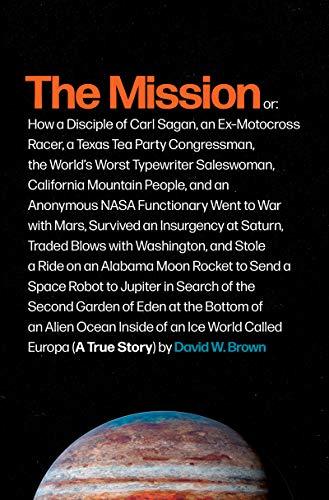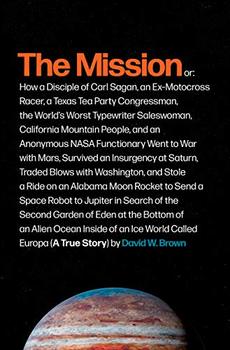
On October 10, 2024, a NASA spacecraft dubbed the Europa Clipper is scheduled to launch toward the large Jovian moon of Europa. It’s expected to arrive in April 2030. The Europa Clipper is just the final expression of a long procession of planned missions to Europa and the other Galilean moons of Jupiter that began in 1997 but never got off the drawing-board. And therein lies a fascinating tale. It’s the subject of David W. Brown’s extraordinary study of NASA and Big Science in action, The Mission. And unlike Mars, the focus of the agency’s almost single-minded attention, Europa’s immense ocean may actually harbor living, breathing extraterrestrial life.
In prose that at times calls to mind the stylistic pyrotechnics of Tom Wolfe in The Right Stuff, Brown follows the brilliant scientists, engineers, and managers at NASA, the Jet Propulsion Laboratory, the Applied Physics Laboratory, and other facilities that became involved over the two-decade period during which the Clipper mission to Europa came to fruition. For anyone with even a modicum of interest in space travel or the ways and means of Big Science, or simply an engrossing story about interesting people, it’s likely to be endlessly fascinating.
The Mission: A True Story by David W. Brown (2021) 482 pages ★★★★★
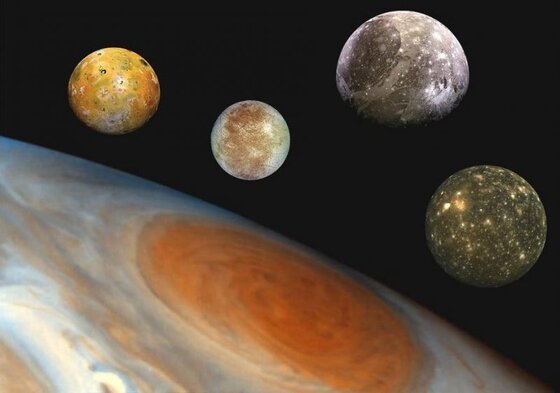
Our evolving view of the solar system
Forget the poster or mobile of the solar system you were showed in school. Remember? There were nine balls of somewhat varying size circling a light bulb or a yellow sphere, and that was it. But that doesn’t even scratch the surface of the reality as astronomers know it today.
What’s really out there
The eight planets—Pluto was demoted to the status of a dwarf planet in 2006—together possess hundreds of moons. Yes, hundreds. Seventy-nine of them circle Jupiter alone (and some believe there are really more than one hundred). It turns out that, unlike Earth, most planets have more than one moon. And, of course, there are millions of asteroids, too, most of which also circle the sun in what is aptly called the Asteroid Belt between Mars and Jupiter. There’s even another dwarf planet among the asteroids: Ceres.
The relative sizes
Forget that light bulb. The sun is inconceivably bigger than even Jupiter, the largest of the planets. Our friend Sol contains 99.8% of all the matter in the solar system. (About one million Earths could fit inside the sun.) And Jupiter holds most of the rest. It’s two-and-a-half times the mass of all the other seven planets put together. So, when you encounter someone likening the Earth to a tiny speck of sand in the vastness of the universe, believe it.
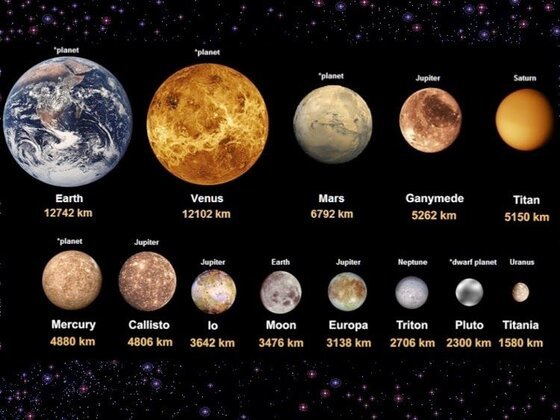
The distances
Astronomers measure distances within the solar system in Astronomical Units (AU). One AU is equal to the average distance of the Earth from the sun, or about 93 million miles. Of course, Venus and Mercury are much closer to the sun, and Mars is just a little bit more distant. But all the rest of all the stuff that circles our star is much, much farther out. Jupiter, the fifth planet out, orbits the sun at an average distance of 5.2 AU, or 484 million miles. The other three gas giants that comprise the outer planets lie far further out: Saturn (9.5 AU, or 887 million miles), Uranus (19.2 AU, or 1.8 billion miles), Neptune (30 AU, or 2.8 billion miles).
But there’s even more
Far, far beyond the orbit of Neptune stretch two inconceivably broad belts of other stuff. First, between 30 and 50 AU, or roughly 2.8 and 4.7 billion miles from us, lies the Kuiper Belt. Then, much further out—between 2,000 and as many as 100,000 AU, or 186 billion and 9.3 trillion miles out—lies the Oort cloud, which may extend one-quarter of the way toward Alpha Centauri, the star that’s nearest the sun. That’s 4.2 light-years away. And a light-year is 63,241 times an AU. Compared to these faraway places, the mission to Europa will be a walk in the park.
A word about travel times
Given today’s state-of-the-art technology, a trip to the moon takes about three days. To Mars, it’s a matter of around seven months. Now get this: “It took seven years for Cassini to reach Saturn. Seven! Galileo took six years to reach Jupiter. Voyager 2 took twelve to turn up at Neptune.” So, when planetary scientists talk casually about a mission to Europa, they’re thinking about a journey that will take at least two-and-a-half years if approached directly. But the Europa Clipper, as presently planned, will not go there in a straight line. Instead, it will employ gravity assist, first around Mars, then around Earth. The full journey to cover 390 million miles—at an average speed of 8,100 miles per hour!—will take five-and-a-half years.
Five central characters
Although Brown’s cast of characters is three pages long, and historical figures including Wernher von Braun and Carl Sagan enter into the tale in significant ways, five less-well-known people play especially prominent roles in the story. All five have been engaged year after year in realizing the dream of planetary scientists for a mission to Europa.
Bob Pappalardo

Robert Pappalardo‘s story begins in Brown’s first chapter. He started work as Europa Mission Project Scientist at the Jet Propulsion Laboratory in Pasadena, California in 2006. His work with NASA began from 1995 to 2001 as a researcher at Brown University, when he worked to plan many of the Galileo observations of Jupiter’s icy Galilean satellites. From 2001-2006, he was an Assistant Professor of Planetary Sciences in the Astrophysical and Planetary Sciences Department of the University of Colorado at Boulder. As Brown notes, “By the time Bob took the job in Boulder, if he wasn’t yet the world’s foremost expert on Jupiter’s icy moons, and Europa and Ganymede in particular, even the world’s most foremost expert might think he was.” Pappalardo’s research focuses on processes that have shaped the icy satellites of the outer solar system, especially Europa and the role of its probable subsurface ocean. He holds a PhD in Geology from Arizona State University. If there is a single protagonist in this tale of the upcoming mission to Europa, that may be Bob Pappalardo.
Louise Prockter

Like Bob Pappalardo, Louise Prockter surfaces in this tale in the very first chapter as a graduate student. She is a geomorphologist, a scientist who studies the origin and evolution of topographical features both on land and below the sea. Geomorphologists seek to understand why landscapes look the way they do. Given the peculiar features of the surface on Europa, Prockter’s inquiries merit high priority. She is the former supervisor of the Planetary Exploration Group at the Johns Hopkins University’s Applied Physics Laboratory. It was Prockter’s discovery of plate tectonics on Europa that helped ensure the approval of Europa Clipper. She received a Ph.D. in planetary geology from Brown University in 1999. Prockter now serves as Director of the Lunar and Planetary Institute (LPI) in Houston, Texas.
Don Blankenship

Don Blankenship‘s current research is focused on understanding the West Antarctic rift system. He uses both airborne and ground-based geophysical techniques, including laser altimetry and radar sounding, among other techniques, to investigate the dynamics of large ice sheets and subglacial geology. Blankenship’s expertise in radar sounding and ice sheets—he is one of the world’s leading scholars in that field—proved instrumental in conceiving the various plans to explore Jupiter’s icy moons that culminated in the mission to Europa now called the Europa Clipper. After all, the almost certain presence of a deep ocean far beneath Europa’s frozen surface is the principal reason for planetary scientists’ desire to study the moon. He had been involved in the work at NASA since 1998. He is currently a Senior Research Scientist at the University of Texas at Austin’s Institute for Geophysics.
Curt Niebur

Curt Niebur was “a green, almost entirely anonymous functionary at NASA headquarters” when he was asked to serve as Program Scientist of a precursor to the Europa Clipper mission, called JIMO—short for Jupiter Icy Moons Orbiter. His LinkedIn bio reveals, “As a Program Scientist I work on robotic space science missions at all stages from formulation through operations.” What doesn’t emerge on LinkedIn is that Niebur has been instrumental in driving the Europa Clipper mission from plan to reality. Niebur’s role in the evolution of the mission to Europa was to poke and prod at the planetary scientists at Jet Propulsion Laboratory and the Applied Physics Laboratory. He “had made it clear that . . . Europa had better bring its A game because no nod was assured” even though the Europa mission had already been selected as NASA’s number two priority!
Ed Weiler

Ed Weiler was the guy at NASA headquarters who kept pulling the rug out from under the planetary scientists plugging for a mission to Europa . . . until he didn’t. (“There was this guy running the science division, Ed Weiler, and it seemed like it was the man’s life work to kill the probe.”) Until his retirement in 2011—Weiler had worked at NASA since 1978—he was the Associate Administrator for NASA’s Science Mission Directorate. He holds a PhD in astrophysics from Northwestern University, which he received in 1976.
If you read histories involving the CIA, the State Department, or many other Washington-based federal departments and agencies, you’ll stumble across multitudes of officials with degrees, often advanced degrees, from the nation’s elite schools. Harvard, Yale, Stanford, UC Berkeley, Princeton, Columbia—they crop up again and again. Not so with NASA. It’s remarkable how few of the scientists and engineers profiled in The Mission hold degrees from the country’s top schools in engineering and science (MIT, Stanford, UC Berkeley, Harvard).
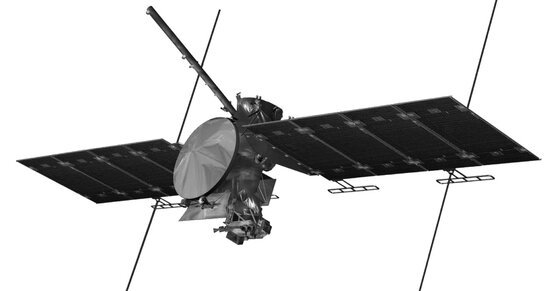
The drama
NASA’s consistent focus on Mars
Ever since Neil Armstrong first set foot on the moon, NASA’s top priority has always been to aim for a human mission to Mars. For decades, the red planet has gobbled up the lion’s share of the talent, funding, and attention whenever NASA, Congress, and the public have focused on space exploration. To date, there have been 49 missions to Mars, including efforts by the Soviet Union and later Russia, the European Space Agency, India, China, and the United Arab Emirates. But as I write only NASA has managed to land a spacecraft—always robotic—on the planet’s surface. In its fourteen attempts, it has succeeded eight times. The cost of all these missions runs to many billions in an era when funding for space has been increasingly difficult to secure. (NASA accounted for 0.48 percent of the federal budget for 2020.) Small wonder, then, that advocates of missions to the outer planets have run into roadblocks.
And therein lies the drama in David Brown’s tale of extraordinary dedication and persistence.
A long, tortuous planning process
“For any planetary body,” Brown explains, “the order of missions went: flyby, orbiter, lander, rover, sample return, astronaut. That’s how Apollo did it.” To date, Europa has been explored exclusively by flyby missions of Galileo. There was a long, long way to go until NASA would even contemplate anything more adventurous. But that didn’t stop the planetary science community from trying. “In seventeen years, there had been eighty-five people, cumulatively, on six science definition teams: Europa Orbiter through 1999, JIMO through 2004, Europa Jupiter System Mission through 2010, the Europa Habitability Mission through 2012, and Europa Clipper through 2014.”
One frustration after another
Just in case it isn’t clear, none of these missions even got off the drawing board until Europa Clipper finally secured a green light from NASA. Years of work by talented scientists and engineers and thousands, even millions of dollars went into planning each of these missions. Then something—usually budgetary limitations, sometimes just Ed Weiler changing the rules of the game—got in the way, and the planning process was halted. It was lot like having Lucy snatch the football away from Charlie Brown at the last minute.
In the end
“In the end,” Brown writes, “it would take seventeen years, six major studies, multiple missions approved, multiple missions abandoned, friendships formed and enmities established, funding raised and budgets lost, congressional hearings, unlikely alliances, technological breakthroughs, terrible losses, and stunning discoveries to get NASA to make it official.” It now appears certain that, sometime within the next two or three years, the Clipper mission to Europa will actually lift off from Earth.
About the author

David W. Brown is a New Orleans-based author whose work generally concerns the space program. He devoted seven years of intensive research and interviews to compile this engaging story of the forthcoming mission to Europa. Brown contributes regularly to The Atlantic, The New York Times, and Scientific American. He is a former U.S. Army paratrooper and a veteran of Afghanistan.
For additional reading
The icy moons of the gas giants in the outer solar system harbor many mysteries. Europa may be the most promising in humanity’s search for life outside Earth. But others offer mysteries of their own. For a fascinating article on planetary scientists’ hopes for Saturn’s moon, Titan, see “Seven Hundred Leagues Beneath Titan’s Methane Seas” (New York Times, Feb. 21, 2021).
Singularity Hub (March 21, 2021) carried a surprising article on this subject, revealing that scientists believe there may be at least seven planets and moons in the Solar System that either currently or in the past have harbored oceans: “Extraterrestrial Life Could Be Hiding in Our Galaxy’s Interior Ocean Worlds.”
You might also be interested in:
- Good books about space travel, including both nonfiction and fiction
- Top 10 nonfiction books about politics (plus dozens of runners-up)
- Science explained in 10 excellent popular books (plus dozens of others)
And you can always find my most popular reviews, and the most recent ones, plus a guide to this whole site, on the Home Page.

